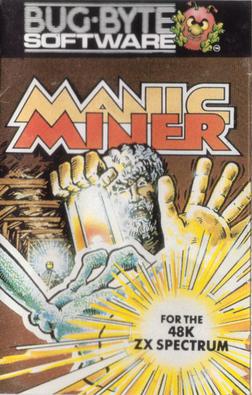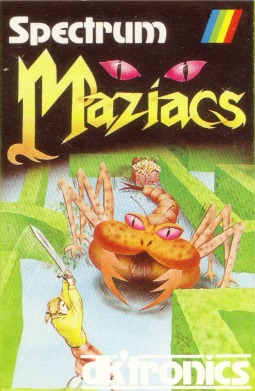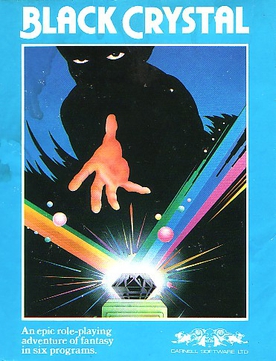
Manic Miner is a platform game written for the ZX Spectrum by Matthew Smith. It was published by Bug-Byte in 1983, then later the same year by Software Projects. The first game in the Miner Willy series, the design was inspired by Miner 2049er (1982) for the Atari 8-bit computers. Retro Gamer called Manic Miner one of the most influential platform games of all time, and it has been ported to numerous home computers, video game consoles, and mobile phones.

Sabre Wulf is an action-adventure game released by British video game developer Ultimate Play the Game for the ZX Spectrum home computer in 1984. The player navigates the pith-helmeted Sabreman through a 2D jungle maze while collecting amulet pieces to bypass the guardian at its exit. The player does not receive explicit guidance on how to play and is left to decipher the game's objectives through trial and error. Sabreman moves between the maze's 256 connected screens by touching the border where one screen ends and another begins. Each screen is filled with colourful flora, enemies that spawn at random, and occasional collectibles.

Jetpac is a shooter video game developed and published by Ultimate Play the Game and released for the ZX Spectrum and VIC-20 in 1983 and the BBC Micro in 1984. It is the first game to be released by Ultimate Play the Game, the company which later became Rare. The game follows Jetman as he must rebuild his rocket in order to explore different planets, while simultaneously defending against hostile aliens. It was written by Ultimate co-founder Chris Stamper with graphics designed by his brother, Tim Stamper. Reviewers praised Jetpac's presentation and gameplay, and it won "Game of the Year" at the Golden Joystick Awards in 1983.

Krome Studios Melbourne, originally Beam Software, was an Australian video game development studio founded in 1980 by Alfred Milgrom and Naomi Besen and based in Melbourne, Australia. Initially formed to produce books and software to be published by Melbourne House, a company they had established in London in 1977, the studio operated independently from 1987 until 1999, when it was acquired by Infogrames, who changed the name to Infogrames Melbourne House Pty Ltd.. In 2006 the studio was sold to Krome Studios.

The Horace video game series was created in the 1980s by William Tang for Beam Software. The series comprised Hungry Horace, Horace Goes Skiing and Horace and the Spiders.

Questprobe: Featuring Spider-Man is the second video game in the Questprobe series.

Eureka! is a video game for the Commodore 64 and ZX Spectrum computers, written by Ian Livingstone, developed by Novotrade for Andromeda Software and published by Domark in 1984.
Quicksilva was a British games software publisher active during the early 1980s.
Crystal Computing, later renamed Design Design, was a British video game developer founded in 1982 by Chris Clarke and Ian Stamp while students at the University of Manchester. Graham Stafford, Neil Mottershead, Simon Brattel and Martin Horsley, joined the company as it expanded. The company's first software release was a compilation of games for the Sinclair ZX81, though it was with the ZX Spectrum that Crystal found its greatest success. A deal with the machine's manufacturer Sinclair to distribute Crystal's Zeus Assembler gave the company sufficient funds for a major marketing campaign for their next product, Halls of the Things, an arcade adventure game that became their most successful title.

Arcadia is a fixed shooter published by Imagine Software for the ZX Spectrum and VIC-20 in 1983. It was later ported to the Commodore 64 and Dragon 32.

Kong Strikes Back! is a 1984 platform video game published by Ocean Software in 1984 for the Amstrad CPC, Commodore 64 and ZX Spectrum. While its predecessor, Kong, is a Donkey Kong clone, Kong Strikes Back! is a clone of Mr. Do's Wild Ride with Donkey Kong-inspired graphics.

Maziacs is an action adventure maze game published by DK'Tronics in 1983 for the ZX Spectrum, Commodore 64, and MSX.

Halls of the Things is a video game developed by Design Design for the ZX Spectrum and released by Crystal Computing in 1983. It was ported to the Amstrad CPC and Commodore 64. The player travels through seven floors of a tower, searching for seven rings, with each floor being a complex maze of corridors and rooms. Once the player has the rings they must then find the magical key hidden in the dungeon, which opens the drawbridge allowing the player to escape. To hinder the player's progress they are attacked by "things," but the player is armed with a sword, arrows, fireballs and lightning to aid you in the quest.

Light Force is a 1986 vertically scrolling shooter designed by Greg Follis and Roy Carter, developed by their company Gargoyle Games, and published under their Faster Than Light imprint. It was released for the Amstrad CPC, Commodore 64, and ZX Spectrum platforms.

The Computer Edition of Scrabble, also known as Computer Scrabble is a computer version of the board game Scrabble, licensed from J. W. Spear & Sons and released by Little Genius for the Apple II in 1982. It was subsequently released for most home computers of the time.

3D Space Wars is a space combat video game written by Steve Turner for the ZX Spectrum and published by Hewson Consultants in 1983. It is both the first game written by Turner and the first in the Seiddab Trilogy.

Mazogs is a maze video game developed by Don Priestley and published for the ZX81 by Bug-Byte in 1982. It was subsequently licensed by Softsync and published in the US for the Timex Sinclair 1000.

Mined-Out is a maze video game created by Ian Andrew originally for the ZX Spectrum home computer in 1983. The objective is to carefully navigate a series of grid-shaped minefields by moving from the bottom to the top of the screen. The number of invisible mines in spaces adjacent to the player's current position is shown but not their precise location, requiring deduction to advance past them and avoid getting blown up. Additional challenges are introduced in later stages.

Black Crystal is an action-adventure game released in 1982 for the ZX81, ZX Spectrum, Commodore 64 and TI-99/4A computers by Carnell Software Ltd. It was the first in the "Third Continent Trilogy" of adventure games; followed by Volcanic Dungeon and The Wrath of Magra.


















